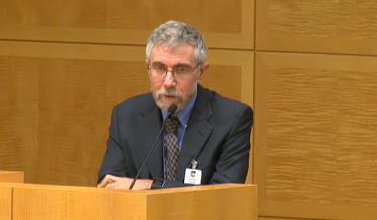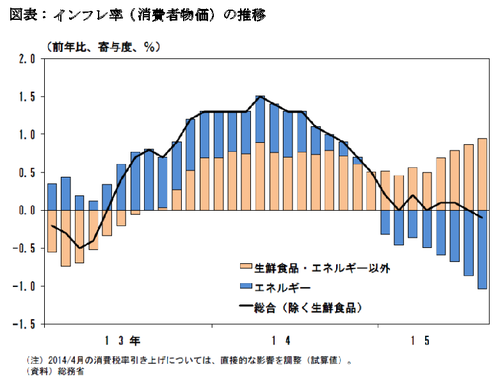
デフレ脱却を図る観点から、日銀は2%のインフレ目標を掲げ、(経済主体の「期待」に働きかける)量的・質的金融緩和(いわゆる異次元緩和)を進めている。
日本のリフレ派がこの政策の重要性を主張あるいは正当化する際、海外の権威の一人として利用していたのが、ノーベル経済学賞受賞者で経済学者のポール・クルーグマン氏であった。
実際、参考1(The Wall Street Journal)の記事の通り、「クルーグマン氏は1998年以降、日銀が「無責任であることを信頼できる形で約束」することが必要」だと主張してきた。
だが、2013年4月の異次元緩和や2014年10月の追加緩和を実施しても、以下の図表の通り、2%のインフレ目標は達成できず、原油価格の下落により、むしろ足元のインフレ率は低下傾向にある。
筆者は元々、異次元緩和の開始当初から、アゴラの記事等で「2%インフレの実現は容易でない」旨の主張をしてきた。
この理由は単純で、過去のインフレ率の推移をみると、1989年は消費増税分が1.4%押し上げているものの、バブル期(1986-1989年)でも、その年平均インフレ率は1%弱に過ぎないためであり、開始から約2年半を経て、やっと異次元緩和の限界が明らかになりつつある。
このような状況の中、参考1のように、クルーグマン氏がIMFの講演(動画はこちら)で、「フォワード・ガイダンスは経済に極めて限定された参加者しかいない場合にのみ機能する」との見方を示し、「無責任であることを信頼できる形で約束すれば、後は自動的に問題を解決できるという考え方は楽観的すぎる。そうなることはない」旨の見解を明らかにしたのである。
つまり、「異次元緩和の帰結や後始末を誰がつけるのか」という疑問が残るが、これはクルーグマン氏が従来の主張を潔く改めたことを意味する。
そして、クルーグマン氏は参考2(The New York Times)のコラムで言及しているように、ラリー・サマーズ元米財務長官と同様、日本を含む先進国が「長期停滞」(Secular stagnation)に陥っている可能性も示唆したのである。
注:「長期停滞仮説」(Secular stagnation thesis)は経済学者のアルビン・ハンセン氏が1930年代に提唱した理論であり、一定の批判もあるが、ラリー・サマーズ元米財務長官が最近復活させたもの。
参考1:
The Wall Street Journal(2015年11月10日 07:11 JST )
クルーグマン氏、日銀のインフレ促進能力に自信失う経済学者のポール・クルーグマン氏は大胆な金融緩和を提唱し、日本銀行の政策に影響を与えてきたが、ここにきてインフレへの効果は限定的だとの見方を示した。
クルーグマン氏は1998年以降、日銀が「無責任であることを信頼できる形で約束」することが必要だと唱えてきた。つまり市場に対し、日銀がより慎重にはならず、インフレ促進へ動くと信じ込ませるような驚きを与えるべきだと主張してきた。
だが先週6日に国際通貨基金(IMF)主催の会合(※)で講演した際、「フォワードガイダンスは経済に極めて限定された参加者しかいない場合にのみ機能する」との見方を示した。さらに「無責任であることを信頼できる形で約束すれば、後は自動的に問題を解決できるという考え方は楽観的すぎる。そうなることはない」と話した。
※ IMF, Economic Forum: Policy Lessons and the Future of Unconventional Monetary Policy, November 6, 2015
参考2:
The New York Times (November 2, 2015 10:20 am)
Liquidity Traps, Temporary and Permanent
(by Paul Krugman)Larry Summers reacts to an offhand post of mine, seeking to draw a distinction between our views. I actually don’t think our views differ significantly now, but he’s right that what he has been saying differs from the approach I took way back in 1998. And I’ve both acknowledged that and admitted that the approach I took then seems inadequate now:
Back in 1998, when I tried to think through the logic of the liquidity trap, I used a strategic simplification: I envisaged an economy in which the current level of the Wicksellian natural rate of interest was negative, but that rate would return to a normal, positive level at some future date. This assumption provided a neat way to deal with the intuition that increasing the money supply must eventually raise prices by the same proportional amount; it was easy to show that this proposition applied only if the money increase was perceived as permanent, so that the liquidity trap became an expectations problem.
The approach also suggested that monetary policy would be effective if it had the right kind of credibility – that if the central bank could “credibly promise to be irresponsible,” it could gain traction even in a liquidity trap.
But what is this future period of Wicksellian normality of which we speak?
Japan now looks like an economy in which a negative natural rate is a more or less permanent condition. So, increasingly, does Europe. And the US may be in the same boat, if only because persistent weakness abroad will lead to a strong dollar, and we will end up importing demand weakness.
And if we are in a world of secular stagnation — of more or less permanent negative natural rates — policy becomes even harder.
(法政大学経済学部教授:小黒一正)















